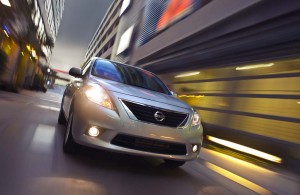
The new Nissan Versa sedan. Nissan was one of the rare few Japanese makers to report a July sales gain.
Sales by Honda and Toyota tumbled again during July even as overall U.S car sales began to regain some momentum last month, raising optimism about the outlook for the balance of the year.
Sales by the major Japanese automakers continued to be hurt by the inventory shortage created by the disruption of production which followed the earthquake that hit Japan in March. Toyota – which has the latest production base in the home market — saw sales drop 19.7% while Honda’s sales fell 25%
A few of the Japanese makers did manage to buck the trend, Nissan reporting a slight 2.7% increase. Subaru, one of the hottest brands in recent months, also reported a meager 2% increase despite an overall increase in the number of unit sales in July.
Chrysler sales increased 20%, giving the long-struggling band its best July showing in five years, General Motors Co. reported an 8% gain in sales compared to July 2010 and Ford said its sales increased 9%.
“Despite all of the negative news headlines, auto sales have increased during July, which is a good sign for all of us,” said Ken Czubay, Ford vice president, U.S. Marketing, Sales and Service. Added Ford sales analyst George Pipas, “The sales rate was better than expected.”
Notable for Ford was the fact that its once-strong Lincoln brand, a relative after-thought in the luxury market in recent years, posted a 40% jump for July.
“We are encouraged to see the stronger pace of auto sales, along with continued customer demand for our fuel-efficient cars, utilities and trucks,” Czubay said. “Fiesta, Focus and Fusion have put Ford back in
the car business,” Czubay said.
However, sales of the new Focus remained constrained by low inventory – recent industry reports pointing to a problem with equipment producing the newly updated model’s instrument panel. Nonetheless, the smaller Fiesta and Focus remain the fastest-turning vehicles on the Ford showroom floor.
Chrysler Group LLC reported U.S. sales of 112,026, a 20% increase compared with sales in July 2010 and the best July sales since 2007.
“In a market that remains tougher than a cheap steak, we were able to produce our highest retail sales in more than three years,” said Reid Bigland, President and CEO – Dodge Brand and Head of U.S. Sales. “I think that statistic is the ultimate testament to the progress we have made with our product in the areas of fuel economy, quality and design.”
Don Johnson, GM vice president, U.S. Sales Operations, said retail sales for GM’s brands rose 6% for the month compared to a year ago, and they also were 1% higher than June.
“Sales of our fuel-efficient cars like the Chevrolet Cruze and our crossovers remain strong, and we’re now also seeing the seasonal lift in full-size pickups that we expected,” Johnson said.
Cruze has nudged aside several traditionally strong Japanese models, including the Honda Civic, to become the nation’s best-selling passenger car in recent months.
Despite early fears, the shortages facing Japanese makers triggered by the March 11 disaster have had little impact on Detroit, European or Korean makers. Nonetheless, the industry as a whole has faced significant headwinds in the past several months – ranging from raw material costs to the impact of a weak economy.
(As TheDetroitBureau.com reported this week, a new study finds high unemployment reducing U.S. car sales by more than a million units this year. Click Here for the full story.) Nevertheless, the industry is poised to regain some of its lost momentum in the second half of the year, aided by higher supply and pent-up demand, Johnson believes.
“There are people who put off vehicle purchases because of uncertainty about fuel prices, vehicle availability and the economy,” he said, but, “As these conditions improve in the latter half of this year, many of these buyers will return to the market.”
Japanese executives also sounded more upbeat than in recent months. “We’re optimistic about the rest of the year,” said Randy Pflughaupt, Toyota Motor Sales vice president of sales administration.
“We look forward to improved inventory levels in the coming months as most of our North American facilities begin to return to full production in August,” said John Mendel, American Honda executive vice
president of sales.
Jeff Bracken, Toyota Division vice president, also emphasized the Japanese auto giant was prepared to defend its claim to having the best-selling car in America.
Saab North America reported an 18% decline in sales, following the recent turmoil at the company home base in Sweden. The maker’s main assembly plant has been out of production since late March due to a boycott by suppliers demanding payment.
But Volkswagen of America, Inc. reported a 21.7% increase over prior year numbers.
“July was a strong month and signaled a good start for the second half of the year,” said Jonathan Browning, President and CEO, Volkswagen of America, Inc. “For the seventh month in a row, we significantly outpaced the industry performance, showing strong baseline demand for our products,” Browning said.
Mercedes-Benz sales increased 16% and BMW sales were up 11%, while Porsche sales climbed 2%. Among the Korean automakers Kia posted a 42% increase in sales, while Hyundai’s sales increased 10%.
“Despite continued weakness in the economy and the ongoing concern over the debt ceiling, consumers continued to purchase vehicles packed with options in July,” said Jesse Toprak, VP of Industry Trends and Insights for TrueCar.com, an internet site devoted to monitoring automobile pricing, purchases and shopping trends.
“Tightened inventories, lower dealer discounting and manufacturer incentives, along with a more expensive product mix resulted in the highest transaction prices we have recorded in the industry.”
(Used car prices slide after months of steady increases – even though July demand hit “blockbuster proportions. Click Here for that story.)
